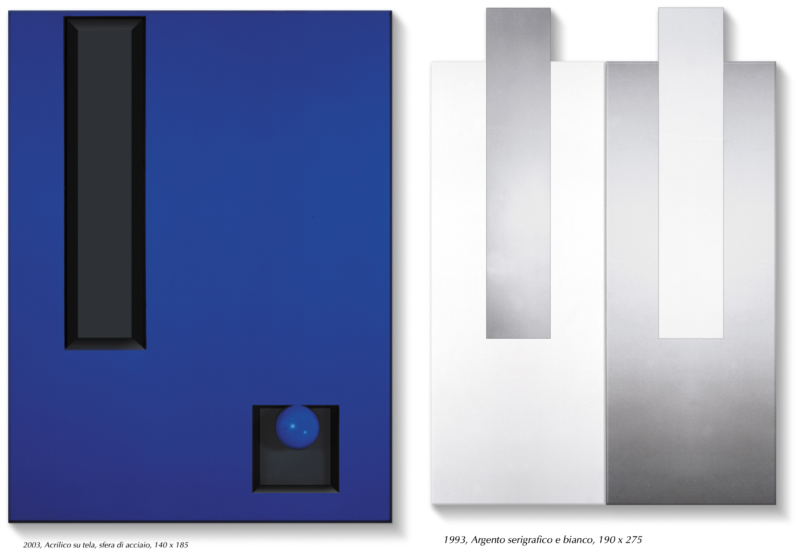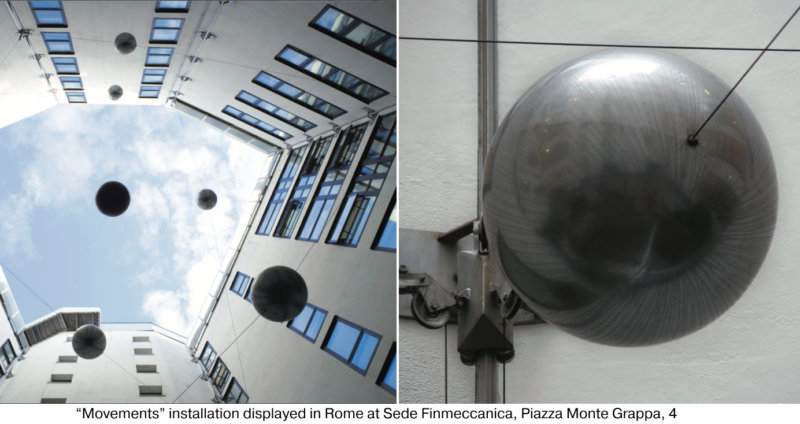Silvana de Stefano is an extraordinary Italian artist and architect with a career spanning over thirty years. She began with painting and later transitioned to sculpture, merging two often divergent worlds through material experimentation and a mastery of large spaces. Her most famous sculptures—”Movements,” “Suspended Column,” and “Elements”—were created for iconic locations, especially in Rome.
In an interview with Fine Art Shippers, Silvana de Stefano discussed her creative process, her approach to space, and her memories of the legendary New York art dealer Leo Castelli.
Artist Talk: Silvana de Stefano on Light and Space
Your artistic journey began in Naples and evolved through such cultural hubs as Rome, California, and New York. How have these different locations influenced your approach to sculpture and painting?
In Naples, when I was about eight, I would stand motionless in front of advertisements for tomato cans—similar to the works of Andy Warhol. I was mesmerized by the magnetic pull of the colors and the simple, clean shapes. This happened in the presence of my mother, who, though annoyed, would still help me tear down the posters to bring them home with me. Those moments remain vivid in my memory, and I believe that’s where my curiosity began for a world that felt like it belonged to me, with its bold colors and immediate, clear, powerful images.
As an adult, I lived and worked in Rome, Berkeley, and New York, and these places shaped my perspective as I explored my identity through painting, sculpture, and architecture. Each city sparked my curiosity and deepened my interest in intellectual pursuits and stimuli. Another transformative experience was in the Sahara Desert, where a silent spiritual call highlighted the beauty and mystery of this surreal, abstract place. The diverse complexities of these experiences are reflected in my creative journey—whether in two-dimensional paintings with contrasting geometric shapes or in well-defined, three-dimensional elements suspended in the air.
Suspension is a recurring theme in your art. One example is the impressive “Suspended Column.” What kind of personal or philosophical narrative does it reflect?
This personal narrative is tied to a reflection on the essence of knowledge. It is a complex and ongoing process that spans a lifetime. Through creative exploration, I examine various relationships with the material aspects of life, as well as a desire not to possess them. For me, immateriality and spirituality are essential ethical principles.
 You've worked on the transformation of an old industrial complex into your studio and living space. How does your personal space influence your artistic practice, and do you feel that the environment in which you create impacts the final outcome of your work? I felt a need for a welcoming and quiet environment where I could live my daily life, concentrate, and work. The loft is contemporary in design and, at first glance, appears larger than its actual size. This is because of the white color that covers all surfaces and the natural light coming through the large windows.
You've worked on the transformation of an old industrial complex into your studio and living space. How does your personal space influence your artistic practice, and do you feel that the environment in which you create impacts the final outcome of your work? I felt a need for a welcoming and quiet environment where I could live my daily life, concentrate, and work. The loft is contemporary in design and, at first glance, appears larger than its actual size. This is because of the white color that covers all surfaces and the natural light coming through the large windows.
In creating this space, I was influenced by the surrounding architecture. We are right next to the Aventine Hill in the center of Rome, near the monumental Aurelian Walls. The pure geometry of the Pyramid of Cestius rises in the square that bears its name, with the rationalist architecture of Libera's Palazzo delle Poste building nearby and, just a few meters away, the tranquility of the Non-Catholic Cemetery, a place of silence and reflection. I had to find a contemporary language that would be in balance and harmony with the architectural context.
It was a project to rehabilitate an old industrial building—a space of about 250 square meters. I designed every detail, from the roof to the floor, selecting materials and contemporary furnishings with a few antique touches in the interiors. I created nine distinct rooms, interconnected by geometric openings placed at various points on the adjoining walls. There are no doors, except for two that lead to the restrooms, and the nine rooms are framed by white walls that contrast with the concrete floor.
Leo Castelli, an influential New York art scene figure, supported your work. What impact did his mentorship have on your career, and how did his guidance influence your creative vision?
Leo Castelli possessed a gift for inner elegance and the grace of kindness. He was an open and cultured person, with a keen eye for new trends and promising artists. I met him at his New York gallery at 420 West Broadway. Entering it was like quietly accessing a sacred temple, with warm, welcoming light and important works of art displayed on the large white walls.
Leo Castelli was warm and lively; he encouraged me to develop my art and showed great interest in my two installations in Rome. His presence in my creative life undoubtedly had a significant influence. For me, everything came to a halt during the cold and painful summer of '99, with the loss of my father and, a few weeks later, the unforgettable Leo Castelli.
In your creative process, do you start with a specific idea or feeling that you wish to convey, or does the form emerge through experimentation with materials and space?
The initial step is an idea focused primarily on form. Even before that, I explore the space to understand its dimensions and potential. I then transfer this conceptual process to paper through sketches and drawings. This allows me to elaborate on the pure idea and stay true to the original. In parallel, I carefully analyze and select materials that are light, flexible, and resistant. I always aim to stimulate the observer's unconscious mind, reflection, and imagination.
As someone who draws from both art and architecture, how do you envision the relationship between art and space evolving in the future, particularly in urban environments?
If I were to imagine a project centered on the theme of art and space, I would draw on my personal knowledge and experience and try to connect the past with the present. Urban environments are dynamic centers where vital and creative energy vibrates and contrasting forces meet. This makes it so stimulating and interesting to explore them.
I am enchanted by the absolute, divine, and spiritual beauty achieved by great artists of the past. In front of immense works, one feels the impulse to reflect on art and its deep mystery. It is impossible to predict the future of art. Being part of it is already quite challenging, and experiencing even a small sense of satisfaction often leads to more quests that every artist pursues.
How do you perceive the role of time in your work—in the making process, in the way materials age or change, or in how viewers experience your installations over time?
Time is an integral part of any work of art, and many works by the great artists of the past are timeless and therefore immortal. Art is always a process—from the idea and design to the execution and exhibition. After completing the creative work, the excitement and inner tension fade only when I see the finished piece done well. This final phase is the most complex, as the work comes to life. Once the piece is finished, I don’t go back to my completed works. Time also plays a crucial role in the lifespan of an artwork. Materials inevitably wear out over time, so artists, architects, and engineers need to consider this. Researching durable materials is important, as well as understanding the factors that affect them. This is a key part of the design process, especially for ensuring the work lasts.

How has your artistic practice evolved over the years, particularly with advancements in technology and materials?
Working with malleable materials like plaster, clay, and cardboard, as well as modeling scaling models, has really helped refine my manual skills. I believe hands-on learning and experimentation are foundational for every artist. At the same time, technology has provided us with innovative materials and tools that are transforming practices in various artistic and architectural fields. I believe this is a great opportunity for professionals in the industry.
Could you tell us about your new work? What it is? What is its concept? How did you work on it?
I'm currently working on design projects. I have already explored this field by designing lamps that are geometric shapes of various sizes, suspended in the air and intended for large spaces such as museums and airports. I am also considering a proposal, still in the planning stage, for an intervention in an ancient monastery.
Interview by Inna Logunova Photo courtesy of Silvana de Stefano

